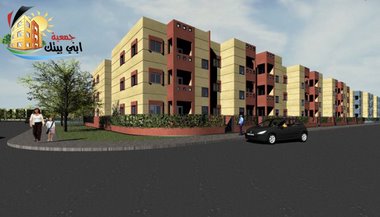 In the Egyptian housing domain, private capital usually prefers to invest in high end housing where the profits are high and the return on investment quick. In a few cases investors may opt for housing for the middle class, but the poorer classes have to depend on the State for their housing. Affordable housing for the needy requires special urban and economic planning which involves State subsidy or long-term financing only possible through the State.
In the Egyptian housing domain, private capital usually prefers to invest in high end housing where the profits are high and the return on investment quick. In a few cases investors may opt for housing for the middle class, but the poorer classes have to depend on the State for their housing. Affordable housing for the needy requires special urban and economic planning which involves State subsidy or long-term financing only possible through the State.Among the State housing projects for the poorer classes is one which gained huge popularity—reflecting the dire need for such type of housing—the project named “Build your home”. This project offered owners three-family, three-storey residential units built on small, separate plots of land. Middle and low-income applicants who qualified were assigned plots of land and were handed the engineering drawings set by the project, as well as the soil investigation reports which specified the foundations required. Owners were bound by a certain period of time during which the building should have been built according to the specifications handed to them; once they complied they were eligible for payment facilities or cash subsidy.
On the surface, the project represents a fine initiative towards empowering middle and poor-income families to own homes. On the ground, however, the project has been bugged with so many obstacles that it can rightly be called “Demolish your home”. The ever-spiralling cost of building material, the non-qualified building contractors who today inundate the market, and the absence of supervision by the State apparatuses concerned, all served to defeat the original purpose of the project.
Predictably, the majority of the new owners were insufficiently aware of the construction, technical, or economic intricacies of the building process, and were thus unable to distinguish between qualified or non-qualified building contractors. How were they then expected to decide on the best-priced contractor operation that complied with the required building specifications? And how were they to check the construction for technical fitness and safety, or to finally take over the building? All these tasks should have been the responsibility of the project officers.
Given the fact that the owners have limited means, it was utterly normal that they should go for the cheapest prices. But cheapest is not always best, especially that, in the process of cutting costs, it was not expected that the owner would hire a civil engineer to supervise the work. The end result was that, in the absence of proper recruitment, assessment, execution, and hand-over, very serious building violations were committed—violations that may very well amount to crimes. Such crimes were committed through the collaboration of both contractor and owner who was only too happy to cut corners and costs at the recommendation of the non-qualified contractor.
I do not cite my opinion out of the blue. As an architect and civil engineer I have been directly involved in uncovering cases where the foundations built or the concrete and iron works did not comply with the original specifications and were thus unfit to carry the load of the building. The results were disastrous: a series of cracks and fractures that may lead to collapses.
It is not right that the execution of ambitious housing projects for limited income families should be left to the owners alone. The financing of such projects should include commissioning large, experienced contracting companies with the task of building the housing units as well as all the service facilities involved, under expert supervision. I am confident the cost will not exceed that which the individual owners pay private non-costly contractors, since it goes without saying that the execution of single units involves steeper overheads than a large project.
The defective “Build your home” project calls to question its actual real estate value, which should have represented an added value to Egypt’s real estate wealth. As it is there are serious doubts about the hypothetical age of the buildings and the real estate value added to the area, to say nothing of the more grievous concerns for the residents’ safety.




